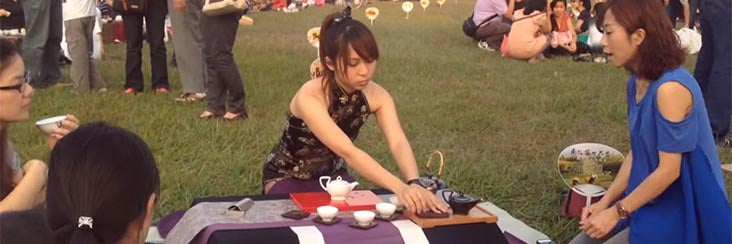
Final day at the Nantou Global Tea Expo, 2013.
The last Sunday in October was the final day of the Nantou County Global Tea Expo. So I made my 4th visit to the event to make a last round of meeting and talking with tea farmers as they wrapped the three week stint of vending their produce, and also to attend the fashion show featuring modern style Chinese women's wear.
I sat in a proper theater that is a remnant of early KMT or perhaps even Japanese Central Government (pre WWII) in Nantou County, and watched women of stature and grace model contemporary renditions of traditional Chinese fashion. The style was naturally elegant in a sort of traditionally dignified way. The tasteful, non-commercial production of the show was also much appreciated. There was an upbeat Asian techno-jazz track that was played intermittently with live performance on the Gu-qin (a piano-type instrument where the strings are plucked rather than struck). It really was a fine fusion of traditional and modern culture.
After the show, I headed to the ice cream vendor who was making fresh ice cream on site of only one flavor per day - that of a locally produced tea. I got to taste Tie Guan Yin Oolong on my first day, and Dong Ding Oolong flavor on my second and last chance to sample the handmade tea-flavored ice cream - made fresh daily throughout the event. It was delicious!
With my cone of Dong Ding Oolong ice cream in hand, I made my way to the long, cavernous, red arched-roof tents filled with hundreds of tea vendors serving their own produce to the public for free. I finally sat down at the table of a farmer who I’d met a few times before and who had told me of his recent project of leasing a tea garden on Dong Ding Mountain and cultivating it organically. Although it has already been tested and certified organic, it is still in its transitional phase in that the yield of leaves is very low as the plants adjust to natural growing conditions. This winter harvest produced a mere 50 jing (approx. 60 lbs) of tea. The type of tea he is making is an interesting innovation however - in a retro sort of way. He is harvesting leaves that have been more or less affected by the insect that is responsible for the creation of Oriental Beauty and Concubine Oolongs. He processes them more in the fashion of Oriental Beauty - drying them into loosely curled leaves that have been 60-70% oxidized and then roasts them at low temperatures in order to completely deplete them of moisture content for stability and preservation purposes.
I sat at a few other tea vendors' tables as the energy of the expo wound down and the farmers began packing up their goods to take home after three full weeks of serving the public at their tea stations. One was a well established tea merchant with 3 stores in Central Taiwan. The guy who served me tea was about my age and has inherited the business from his father. They specialized in traditional style teas such as Oriental Beauty, Tie Guan Yin (original style rather than the new trend of Green Guan Yin), Aged Oolongs, and Black Teas. I really appreciated their classy yet modest brand representation. I felt like I was talking with a true traditional tea merchant in the 21st Century. It was a very brief yet poignant meeting and I really look forward to visiting their home base in Nantou City some day in the near future.
I also met a farmer with a tea garden located in an area I did not know tea was grown - on the eastern slopes of He Huan Mountain, where I've ridden many times and knew there were no roads off of the main route that traverses the pass at about 3000m. The eastern side is gorgeous rugged terrain with patches of primary growth below the treeline and zero development other than a solitary hotel with stunning views of sunrise above a sea of clouds almost daily. I learned from this farmer, however, that there are foot paths from the main road, as well as monorail tracks run by power generators to cart the bushels of fresh tea leaves harvested by hand on land that is only accessible on foot. So these bushels of freshly picked leaves are collected at the roadside and carted off to a nearby factory for processing. This is a new frontier of high mountain tea cultivation that I have yet to explore, and in an area that is some of the most rugged and undeveloped high elevation terrain that I have seen in my 20 years of mountain exploration.
The main purpose of my final visit, however, was to continue into the foothills of Deer Valley to celebrate the conclusion of a job well done by the organizer of the Expo - Tony Lin. It was a celebration of the simplest kind. Tony, his wife Lisa, the new principal of the local Junior High School - Patricia, who acted as MC of various events at the Expo, and I all headed for Tony and Lisa's home in Lu Gu from the Expo. We arrived after dinnertime, but none of us had eaten, so Lisa got creative in an impromptu way to feed us from her kitchen that had been neglected during their busy expo time. Soon after, we were joined by a mutual tea friend who I’ve known for a long time and have learned a lot from in the last several years in relation to Taiwan tea, as well as fine Scottish Whisky - which he provided for the occasion.
Video of the '1000 People Brew Tea Event' at the Nantou Global Tea Expo, 2013.

